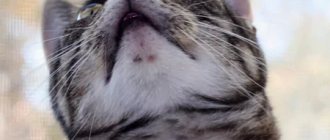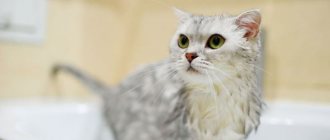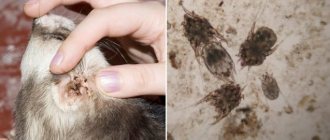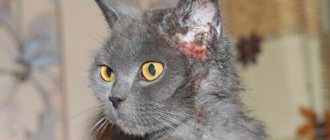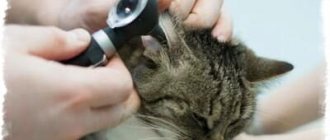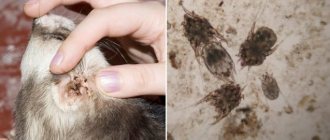Acne in cats is a dermatological disease caused by a malfunction of the sebaceous glands. Pets of any age and type are susceptible to it, and the disease is common.
The rash can be mistaken for plaque, dandruff or dirt. Visually, this is an area of densely located small pimples on an inflamed, slightly swollen area of the skin. An acne accidentally noticed by an owner on a cat's chin can cause considerable surprise and confusion. But, just like in humans, cats' skin pores become clogged due to the mass of the old layer of cells stuck to the young skin cells by sebaceous secretions.
Depending on the location of the plug, blackheads appear as white or black dots and can be located inside or outside the pore. Although sebaceous glands are found throughout the body, in most cases it is easier to notice cat acne on the chin and around the lips. But inflammation can also occur in other places: for example, in hairless breeds (Sphynxes), rashes can be more often noticed in the tail area. There are single or occasional lesions that are cyclical (seasonal) or permanent. Often proceeding without exacerbation or pathology, the disease ends with recovery - cleaning of the pores. But if pathogenic microbes manage to penetrate deep into the skin, then problems arise: the affected area itches and hurts, the pet cannot find a place for itself. Therefore, if acne is detected in a cat, treatment should be started immediately.
Hurry up, choose a box and find out what gift awaits you
Discount on pet insurance
Promo code copied to clipboard
Causes of the disease
Inflammation of the sebaceous glands in cats is a skin disease called acne. Acne appears in the form of blackheads or blackheads. The most common area of occurrence is the chin and lip area.
There are various reasons why this skin disease appears, the main ones are:
- stressful situations, which result in disruption of the sebaceous glands and the production of large amounts of sebum;
- poor hygiene when licking yourself in hard-to-reach places, such as the chin;
- skin diseases;
- allergy;
- disturbances in the development of the sebaceous glands;
- weak immunity;
- fatty food;
- the porosity of the material of plastic animal feeding bowls, allowing bacteria to accumulate in the pores due to irregular washing of dishes.
Where can acne appear in cats?
For experienced cat lovers, rashes can look like waste products of parasites, so you need to figure out what the cause of blackheads is. If they cannot be brushed off or quickly cleaned, it means they are deep in the pores and have nothing to do with parasites. Where can you most often see them?
Acne on a cat's chin is the most common location. The pet often scratches its chin, rubs it against objects both inside and outside the house, thereby introducing a secondary infection and injuring itself even more. In addition, it is this part that is least accessible for washing, and therefore least protected from infection. The affected area of the chin looks dry and flaky, with local hair loss, with characteristic acne and redness.
The muzzle is the calling card of a cat. Among the things that the animal usually rubs against at home are furniture legs, corners of sofas, baseboards and, of course, toys. This behavior is dictated by a sense of security, since the cat leaves its scent on those things that it recognizes as personal. Therefore, a cat's face has the second highest risk of acne. Characteristic rashes occur around the lips and near the ears above the eyes.
The glands, which play the role of a business card, are present not only on the head, but also at the base of the tail. Due to their constant work, hair follicles secrete a certain secretion. When it settles on the skin and fur, it can lead to acne around the tail.
Rashes are much less common on other parts of the body. These areas are characterized by short hair or hairless areas - for example, around the nipples, in the armpits, near the genitals, between the fingers, in the groin.
Which breeds are more susceptible
Skin pathologies in the form of acne are common in cats of different breeds, different ages, and different genders.
Of course, at risk will be those cats who:
- tableware hygiene is not observed;
- the diet is not adjusted towards a balance of microelements, vitamins and nutrients;
- there is no control over the cleanliness of the skin, including in places that are difficult to lick.
At-risk groups
Veterinarians believe that the appearance of acne is not related to the breed, age or gender of the pet. Pathologies can be either isolated or regular, cyclical, depending on the cause of the disease.
Statistics show that castrated and sterilized animals are less susceptible to the disease, but even in this case its occurrence is not excluded.
Most often, acne appears repeatedly in cats, so it is important to completely cure the animal the first time acne appears.
In individuals with long hair, lesions may appear on the face and in the folds of the skin. The only exception is hairless cats (Sphynxes), due to greater sebum secretion than other breeds, these animals have a higher risk of acne. Careful care helps eliminate the risk of pathology.
Main symptoms
In the early phase, acne appears as black dots, which can be confused with dirt or sand in the fur. If you do not pay attention to the changes that have arisen in your pet’s appearance, then the next phase will be redness of the skin and swelling of the affected area.
The pet begins to itch, wounds with bloody discharge may appear at the site of scratching, and if the cat is not treated at the initial stage, the skin disease will progress and reach the appearance of ulcers, and in some cases, to patchy baldness.
If symptoms of itching, restlessness and skin rashes appear in your pet, you should immediately contact a veterinary clinic to have your animal examined.
Special diet
During treatment, the veterinarian will most often immediately recommend putting the cat on a special diet, eliminating any fatty and high-calorie foods from the diet. This is done in stages:
- Refusal of dry and canned food.
- Introduction of fiber and carbohydrates into the diet, usually in the form of porridges made from oatmeal and pearl barley.
- Adding vegetable or fruit stews and purees to the daily portion of food.
- Addition of vitamin complexes (ascorbic acid, vitamin A, tocopherol). It is important to observe their correct dosage. Excess can cause allergic reactions, and deficiency can cause vitamin deficiency.
Diagnostics in a veterinary clinic
Going to the clinic with your pet is mandatory, since the symptoms of acne are similar in their symptoms to such dangerous diseases as sarcoptic mange (scabies), eosinophilic (linear) granuloma, demodicosis (subcutaneous mite), dermatomycosis (ringworm). The appearance of acne can also be associated with an allergic reaction.
To make an accurate diagnosis, the clinic will take a skin scraping from your pet for analysis. The biomaterial is studied for the presence of bacteria and fungi.
The results of the analysis, if they confirm acne, will allow the doctor to prescribe the correct treatment and recommend that the animal owner eliminate possible household factors that irritate the animal’s skin or make changes to its diet.
What are pimples, acne and blackheads?
The skin of an animal has sebaceous glands, and there are more of them where there is less hair. These glands produce a special secretion (sebum or sebum). But sometimes too much is added or the consistency changes towards thickening. This leads to blockage of the gland duct and the formation of an inflamed area of skin. A fatty, viscous secretion, isolated from air, is an excellent “tasty” environment for the proliferation of pyogenic bacteria. The result of this process is acne.
If the secretion accumulates under the skin and the surrounding tissues become inflamed due to the proliferation of bacteria, this is called a closed comedon. If sebum comes to the surface, oxidizes and blocks the duct of the sebaceous gland, a blackhead (blackhead or open comedon) is formed.
Acne is a complex disease associated with inflammation of the hair follicles. Accompanied by acne with elements of both types and hyperemia at the site of the rash. In cats, they most often appear on the chin, a little less often on the ears and neck, and even less often in the tail area. The location of the rash is determined by the location of the sebaceous glands. In cats, most glands of this type are located on the eyelids and chin; there are quite a lot of them along the back in the area of the tail and foreskin.
Treatment method and prognosis
When treating cats for acne, you must:
- follow all doctor's orders;
- exclude excessively fatty foods from the diet;
- if there is a lack of vitamins, include them in the cat’s diet;
- Do not squeeze out blackheads on your cat’s skin;
- replace plastic utensils with glass, ceramic or stainless steel utensils;
- Wash animal utensils used for industrial wet or natural food at least twice a day.
When treating a cat for acne, the owner needs a patient and caring attitude towards recovery. Cat acne is not contagious to people and does not cause pain to the animal if it is not advanced and does not bother the pet with itching. In general, the prognosis for recovery is favorable.
Traditional treatment scheme
Veterinarians claim that with proper treatment of isolated cases of acne, a complete recovery of the animal is possible without relapses.
If comedones reappear, the cat will most likely need lifelong treatment and daily hygiene procedures.
When the disease is in an advanced stage, bloody scratches form in place of the blackheads and a secondary infection occurs - a fungal or bacterial infection of the skin. Timely contact with a veterinarian and comprehensive therapy will help prevent the disease from developing serious complications.
In complex treatment, the following drugs and procedures are prescribed:
- Antiseborrheic shampoos such as Lactaderm and Doctor. They contain sulfur, salicylic acid, benzoyl peroxide, ethyl lactate, which help remove fat and dirt and have a drying effect. Wash the animal once or twice a week.
- Products with local cleansing and antiseptic effects. This could be Chlorhexedine, Furacilin solution, Miramistin, hydrogen peroxide. In addition to disinfection, these drugs help relieve itching.
- Brilliant green or iodine - applied to the affected area after antiseptic treatment, dried and disinfected comedones.
- Ointments and gels with anti-inflammatory and drying effects - Flucinar, Levomekol, Tetracycline, Leniment synthomycin, syntomycin and zinc.
- Antibacterial ointments or gels, such as Mupirocin, Flemoxin salutab or Bactroban.
- Combined preparations in the form of ointments with benzoyl peroxide and antibiotic (Baziron, Zinerit).
- Retinoid ointments with vitamin A (Differin, Adacoin) have an immunomodulatory and anti-inflammatory effect, preventing follicle blockage.
- Systemic antibiotics are prescribed only in difficult cases - when blackheads turn into ulcers, follicles and infected wounds. 90 percent of acne diseases are cured without antibacterial injections. Amoxicillin, Enrofloxacin, and cephalosporins are usually prescribed.
What to do at home
Like other cat diseases, acne can be treated as prescribed by your veterinarian.
In order for the therapy to give the expected result, the owner needs to understand why the normal functioning of the sebaceous glands on the cat’s body has been disrupted. To do this, it is necessary to follow all the recommendations prescribed by the doctor and, after the course of therapy, establish control over the introduction of new foods, especially fatty ones.
It is important to remember that excess vitamins can also cause acne outbreaks. Therefore, vitamins also need to be given in doses.
It is necessary to monitor the hygiene of the dishes, and also wipe the cat’s chin after eating, which is difficult to lick on its own. You can wipe it with a cotton swab dipped in a decoction of calendula or chamomile.
How to care for a sick cat
It is better to shave the fur on the acne-affected area. Areas with blackheads and inflammation should be washed daily with tar soap and special gels. They are applied with a swab, then carefully washed off with a damp cloth and blotted dry.
Sometimes acne is steamed and blockages in the hair follicle are removed. A hot cotton napkin soaked in chamomile decoction is applied to the affected area.
In complex therapy, ointments and gels are used as adjuncts to prevent the formation of ulcers and inflammation and are used until acne completely disappears. They are applied for 30-40 minutes, then the excess is removed with a cotton swab.
Before using them, the skin is cleansed with antiseptic agents.
Sometimes castration helps in the treatment process; after this procedure, hormonal levels decrease and acne may go away on its own.
When using any external therapy (liquid solutions, gels and ointments) to prevent poisoning, you must ensure that the cat does not lick itself.
Squeezing out acne from your pet is strictly prohibited.
If pus spontaneously discharges from burst pimples, it is carefully removed with cotton swabs. When drying crusts form, they are not removed, but wait until they fall off on their own.
Possible complications
If you do not provide qualified assistance to your cat in a timely manner and allow the formation of blood wounds after scratching acne areas, then a secondary infection may develop on the skin. Damaged skin is a gateway for infection; any fungus or bacteria will complicate the pet’s condition.
The right decision would be for the animal owner to contact the clinic at the initial signs of the disease, avoiding re-infection.
Mr. Cat recommends: is there a danger to humans?
With any illness in an animal, there is a danger of infection and fear for the household. But in the case of cat acne, there is no need to worry - this pathology is absolutely safe for people. Caring for a sick animal will not bring any harm to a person.
Acne occurs for a number of reasons; this disease is not viral. Even small children, the elderly and people with a low immune background will never get acne from a sick cat.
Read the article about what a person can actually get infected from a cat.
How to properly cleanse your pet's skin with acne
Before you begin the procedures, you need to understand the sequence in which they are performed. To ensure success, let's look at the following step-by-step instructions.
Step #1. Washing the skin
The pet's skin must be cleaned with a specialized shampoo, which we already mentioned earlier. The water should not be hot or cold, so as not to provoke thermal damage to the diseased area of the skin. Make it warm and comfortable for the animal. Gently apply the mixture, lather it gently and wash the animal, removing excess fat and dirt from the surface of its skin.
Wash your pet with a special shampoo
Step #2. Disinfect damaged areas
After you wash your cat, wipe the affected areas with hydrogen peroxide, chlorhexidine, or something similar. However, it is best not to use alcohol for this; its effect is too aggressive.
The pet's skin should be wiped very carefully
Step #3. Steam boils
Steaming boils is done using water that has been boiled and cooled to an acceptable temperature and a cotton napkin. Moisten a cloth with water and apply it to the boils, softening them.
It is prohibited to squeeze boils on a cat yourself; this should only be done by a veterinarian.
Step #4. Applying ointments
At the fourth stage, ointments are applied, which are designed to nourish, moisturize and disinfect the animal’s skin. They are applied generously, but not too much, so as not to clog the pores, thereby provoking the appearance of new spots.
Apply the ointment carefully
Please note: application must be done gently. Otherwise, the use of the drug will have the opposite effect, as you will damage the skin and rub the infection into it.
The dangers of cat acne
Pathologies caused by blockage and further inflammation of the sebaceous glands are not always considered by owners to be serious problems. However, acne should not be left unattended.
For the animal itself
The pet experiences great discomfort from the accumulation of black spots on the chin, around the nose, mouth, and at the base of the tail. The cat scratches the affected areas of the body and brings dirt into the wounds. As a result, purulent ulcers and crusts of blood are formed. Pathogenic microorganisms can penetrate through them, causing dangerous infections that are long and difficult to treat.
For man
The skin pathology, which is unpleasant for the pet fluffy, is not contagious to the owner and his family members. Only infections that accompany an advanced form of illness (for example, lichen) can be dangerous to humans. Therefore, it is impossible not to treat and allow further spread of acne throughout the animal’s body.
